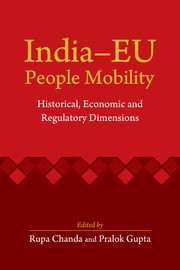Book contents
- Frontmatter
- Dedication
- Contents
- List of Tables, Figures and Boxes
- List of Abbreviations
- Preface
- Acknowledgements
- 1 India–EU People Mobility: Present Status and Policy Perspective
- 2 Economic Linkages and India–EU Mobility
- 3 Indian Diaspora in the EU
- 4 Goans in Portugal: History, Identity and Diaspora Linkages
- 5 Facilitating India–EU Mobility of IT Professionals
- 6 Movement of Indian Architects and Engineers: Prospects and Challenges in the EU
- 7 Mobility of Indian Legal Professionals to the EU: Understanding the EU's Regulatory Regime
- 8 Exploring India–EU Student Mobility
- 9 The Way Forward to a Strategic Engagement
- Contributors
- Index
2 - Economic Linkages and India–EU Mobility
Published online by Cambridge University Press: 05 January 2016
- Frontmatter
- Dedication
- Contents
- List of Tables, Figures and Boxes
- List of Abbreviations
- Preface
- Acknowledgements
- 1 India–EU People Mobility: Present Status and Policy Perspective
- 2 Economic Linkages and India–EU Mobility
- 3 Indian Diaspora in the EU
- 4 Goans in Portugal: History, Identity and Diaspora Linkages
- 5 Facilitating India–EU Mobility of IT Professionals
- 6 Movement of Indian Architects and Engineers: Prospects and Challenges in the EU
- 7 Mobility of Indian Legal Professionals to the EU: Understanding the EU's Regulatory Regime
- 8 Exploring India–EU Student Mobility
- 9 The Way Forward to a Strategic Engagement
- Contributors
- Index
Summary
Introduction
The last two decades have witnessed the opening up of the Indian economy to greater participation in international trade and investment flows. In this period, the European Union (EU) has emerged as one of India's major trading partners accounting for over 15 per cent of India's international trade and an important source of foreign direct investment flows. During the same period, there has also been significant emigration of Indians to traditional destinations within the EU such as the United Kingdom (UK) as well as to other countries such as Italy, Germany and France. There are currently over one million Indians residing in the EU – low- and high-skilled workers, professionals, students, dependents and others, who in turn generate substantial remittances that flow to India for family maintenance and investment purpose.
This chapter assesses the relationship between India–EU labour mobility and economic linkages across three key dimensions – trade, investment and remittances. It shows the significance of migrant and diasporic networks with regard to trade creation and cross-border investment flows between India and the EU and remittance flows from EU countries to India. Sectoral examples are used to illustrate these linkages, such as the US$ 14 billion India–EU diamond trade that represents nearly 15 per cent of total India–EU merchandise trade and reflects the role of diasporic communities and trade in food products that reflects the trade creating effects of ethnic preferences; the importance of intra-company transfers and visa policies in shaping investment ties in key sectors such as Information Technology (IT), and the role of migration in shaping the magnitude and regional distribution of remittance flows.
Table 2.1 describes the magnitude of India–EU economic linkages: Over US$100 billion in bilateral trading volumes with a small surplus in favour of the EU, over US$60 billion in bilateral direct investment stocks and US$7 billion and US$10 billion worth investment and remittance flows, respectively, almost entirely directed towards India.
- Type
- Chapter
- Information
- India–EU People MobilityHistorical, Economic and Regulatory Dimensions, pp. 28 - 51Publisher: Cambridge University PressPrint publication year: 2015



